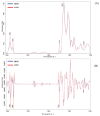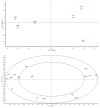The significant influence of residual feed intake on flavor precursors and biomolecules in slow-growing Korat chicken meat
- PMID: 33677913
- PMCID: PMC8495355
- DOI: 10.5713/ab.20.0736
The significant influence of residual feed intake on flavor precursors and biomolecules in slow-growing Korat chicken meat
Abstract
Objective: This study investigated the association between feed efficiency, physicochemical properties, flavor precursors and biomolecules in the thigh meat of Korat (KR) chickens.
Methods: The feed intake and body weight of individual male KR chickens were recorded from 1 to 10 weeks old to calculate the individual residual feed intake (RFI) of 75 birds. At 10 weeks of age, chickens with the 10 highest (HRFI) and lowest RFI (LRFI) were slaughtered to provide thigh meat samples. The physicochemical properties (ultimate pH, water holding capacity [WHC], drip loss) and flavor precursors (guanosine monophosphate, inosine monophosphate (IMP), adenosine monophosphate and inosine) were analyzed conventionally, and Fourier transform infrared spectroscopy was used to identify the composition of biomolecules (lipids, ester lipids, amide I, amide II, amide III, and carbohydrates) and the secondary structure of the proteins. A group t-test was used to determine significant differences between mean values and principal component analysis to classify thigh meat samples into LRFI and HRFI KR chickens.
Results: The physicochemical properties of thigh meat samples from LRFI and HRFI KR chickens were not significantly different but the IMP content, ratios of lipid, lipid ester, protein (amide I, amide II) were significantly different (p<0.05). The correlation loading results showed that the LRFI group was correlated with high ratios of lipids, lipid esters, collagen content (amide III) and beta sheet protein (rg loading >0.5) while the HRFI group was positively correlated with protein (amide I, amide II), alpha helix protein, IMP content, carbohydrate, ultimate pH and WHC (rg loading >0.5).
Conclusion: The thigh meat from chickens with different RFI differed in physiochemical properties affecting meat texture, and in the contents of flavor precursors and biomolecules affecting the nutritional value of meat. This information can help animal breeders to make genetic improvements by taking more account of traits related to RFI.
Keywords: Biomolecules; Flavor Precursor; Physicochemical Properties; Residual Feed Intake; Slow-Growing Chicken.
Conflict of interest statement
We certify that there is no conflict of interest with any financial organization regarding the material discussed in the manuscript.
Figures



Similar articles
-
Phenotypic correlations between feed efficiency, growth, and meat quality of slow-growing chickens.Br Poult Sci. 2022 Dec;63(6):742-746. doi: 10.1080/00071668.2022.2094218. Epub 2022 Jul 1. Br Poult Sci. 2022. PMID: 35749274
-
Thigh muscle metabolic response is linked to feed efficiency and meat characteristics in slow-growing chicken.Poult Sci. 2023 Jul;102(7):102741. doi: 10.1016/j.psj.2023.102741. Epub 2023 Apr 23. Poult Sci. 2023. PMID: 37186966 Free PMC article.
-
Mitochondrial genes and antioxidant mechanisms in the duodenum relate to feed efficiency in slow-growing chickens.Poult Sci. 2025 Aug 9;104(11):105669. doi: 10.1016/j.psj.2025.105669. Online ahead of print. Poult Sci. 2025. PMID: 40840290
-
Effect of residual feed intake on hypothalamic gene expression and meat quality in Angus-sired cattle grown during the hot season.J Anim Sci. 2014 Apr;92(4):1451-61. doi: 10.2527/jas.2013-7020. Epub 2014 Feb 10. J Anim Sci. 2014. PMID: 24663166
-
Effect of divergence in residual feed intake on expression of lipid metabolism-related genes in the liver of meat-type ducks1.J Anim Sci. 2019 Sep 3;97(9):3947-3957. doi: 10.1093/jas/skz241. J Anim Sci. 2019. PMID: 31325379 Free PMC article.
Cited by
-
Identification of Metabolites in Muscles of Lueyang Black-Bone Chickens: A Comparative Analysis of Caged and Cage-Free Rearing Modes Using Untargeted Metabolomic Techniques.Animals (Basel). 2024 Jul 12;14(14):2041. doi: 10.3390/ani14142041. Animals (Basel). 2024. PMID: 39061503 Free PMC article.
-
Metagenomic insights into the relationship between gut microbiota and residual feed intake of small-sized meat ducks.Front Microbiol. 2023 Jan 18;13:1075610. doi: 10.3389/fmicb.2022.1075610. eCollection 2022. Front Microbiol. 2023. PMID: 36741899 Free PMC article.
-
Biomolecules, Fatty Acids, Meat Quality, and Growth Performance of Slow-Growing Chickens in an Organic Raising System.Animals (Basel). 2022 Feb 24;12(5):570. doi: 10.3390/ani12050570. Animals (Basel). 2022. PMID: 35268139 Free PMC article.
References
-
- Thornton G. The expanding market for slow-growing broilers. In: Thornton G, editor. Watt Poultry USA. Rockford IL, USA: Watt Global Media; 2016. pp. 22–6.
-
- Katemala S, Molee A, Yongsawatdigul J. Effect of age on physico-chemical properties of Korat chicken meat. Proceedings 6th Meat Science and Technology Conference; 2018 June 18–19; Bangkok, Thailand. 2018. pp. 49–56.
-
- Donohue M, Cunningham DL. Effects of grain and oilseed prices on the costs of US poultry production. J Appl Poult Res. 2009;18:325–37. doi: 10.3382/japr.2008-00134. - DOI
-
- Alexandratos N, Bruinsma J. World agriculture towards 2030/2050: the 2012 revision. Rome, Italy: FAO; 2012. (ESA Working paper No. 12-03 [Internet]). [cited 2020 Dec 28]. Available from: http://www.fao.org/3/a-ap106e.pdf.
-
- van der Werf JHJ. Is it useful to define residual feed intake as a trait in animal breeding programs? Aust J Exp Agric. 2004;44:405–9. doi: 10.1071/EA02105. - DOI
Grants and funding
LinkOut - more resources
Full Text Sources
Other Literature Sources

